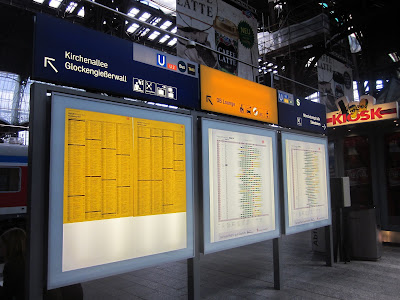 Over two months remain until the 34th annual Harz Gebirgslauf, a traditional running event that’s drawn around 3,000 yearly participants to the Harz National Park every second weekend of October since 1978, but Christiane Schierhorn (55) has already considered which race she’ll participate in this year. For Schierhorn and her husband, Christoph, both long-time residents of Wernigerode, Germany, the question is not of participation—he’s competed in the event all 33 years, she all except for in 1980 and 1983, when she was pregnant with the couple’s two children—but simply selection of the most fitting race for their current life situation.
Over two months remain until the 34th annual Harz Gebirgslauf, a traditional running event that’s drawn around 3,000 yearly participants to the Harz National Park every second weekend of October since 1978, but Christiane Schierhorn (55) has already considered which race she’ll participate in this year. For Schierhorn and her husband, Christoph, both long-time residents of Wernigerode, Germany, the question is not of participation—he’s competed in the event all 33 years, she all except for in 1980 and 1983, when she was pregnant with the couple’s two children—but simply selection of the most fitting race for their current life situation.The location alone would justify the trip and entrance fee for most athletes. With a start edging Hasserode, Wernigerode’s western city component, the 2 km children’s run, the 5 km, the 11 km, the half marathon as well as the 10 and 25 km hiking/Nordic walking competitions foray through woods golden with bright fall leaves, past small forest ponds and, for the longer stretches, up over lookout points offering views of the red-roofed neighboring villages, windmilled farmscape and to northern Germany’s highest point, the Brocken. Especially aspiring athletes can do more than glimpse the Brocken in passing, though. The Brocken Marathon leads participants on a path straight up to the 1,142 m summit (3,743 ft) before curving back down into Wernigerode.
The Schierhorns, however, add another level of personal importance to the race: it was the catalyst that brought the couple back together again, leading to their eventual marriage.
Although Schierhorn had been in the same class with Christoph at Gerhard Hauptmann Gymnasium, one of three grammar schools in Wernigerode, they were only a couple for six months before breaking the relationship and beginning university studies.
In 1978, Schierhorn was home on break from her university in Potsdam and happened to run into Christoph, looking at the large posters advertising the first Harz Gebirgslauf. The premiere event offered three distance categories: 13km, 23km and marathon.
 |
| Advertising in Wernigerode for the 33rd annual Harz-Gebirgslauf. |
“I knew [Christoph] was very keen to take part in this sports event,” Schierhorn said.
She also knew that if she registered herself as well, she would be able to meet him again in Wernigerode that October, something she was extremely keen on.
Today, Schierhorn boasts a slew of athletic achievements, including two marathons and a 90 km cross-country ski race. When she registered for that first 11 km, though, she wasn’t a runner at all.
Motivated by the desire to impress Christoph and to improve her body image, she took her training seriously, running different circles every day in the forest bordering her Potsdam dormitory. At last, she reached a training distance of 8 km.
“If I managed 8 km, I can manage more,” she thought.
Her reasoning proved correct as Schierhorn successfully completed her race, ranking 2nd fastest in the women’s division.
“My [now] husband was very proud, and we were a couple again,” she summarized.
The combined draw of romance and race continued to attract the couple, married in July 1980, turning the event into a family tradition. Both of the Schierhorn’s children have also participated in the race, though more infrequently than their parents. Schierhorn always prepares a special cheese and spinach pasta for the Friday night pre-race dinner, and the family celebrates with friends after the race on Saturday, enjoying cake, coffee and tea. Occasionally, they’ve also attended the Harz Gebirgslauf-sponsored “Sportlerparty.”
Christoph, who has completed the marathon 6 times and the 11 km 19 times, collects the annual results booklets, carefully highlighting the times of family and friends.
“It’s like a hobby for him—he reads all the results, reads all the names,” Schierhorn explained.
She enjoys the atmosphere, the people and the weather, which, with few exceptions, has almost always been sunny.
“It’s a very nice countryside; it’s important because it’s in my hometown,” she said. “I know a lot of the sportsmen and sportswomen. It’s a little bit like a family.”
Christoph received a commemorative prize after his 20th and 30th consecutive participation, and Schierhorn was titled “Miss Harz Gebirgslauf” in 1998. She continued to push herself athletically, completing the Brocken Marathon in 2001 with a time of 4:31:26, five years after finishing her first marathon in Berlin.
“My dream was to manage [the Brocken Marathon] once in my life,” she said. “It was a perfect day—sunny. I had a perfect view on top of the Brocken, more than 70 km.”
At 45, she was also up for the challenge physically.
“It was hard, but it was easier than the marathon in Berlin because I was better prepared,” she said.
Nowadays, the couple both struggles with knee problems, with Schierhorn favoring the walking events in recent years.
“Sometimes I think it’s better to do nothing, but it’s a good tradition,” she said.
And, maybe, an even better story.
***
This year’s events will take place on October 10, 2011. For more on the Harz Gebirgslauf, including information about routes and registration, visit the official Web site: http://www.harz-gebirgslauf.de

